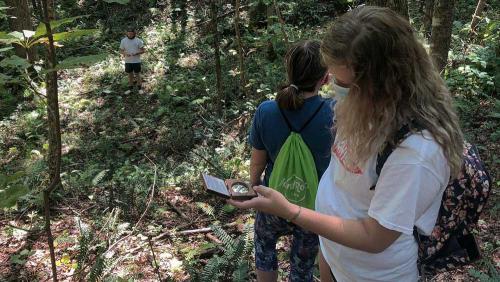Students Discover New Science on Salamanders

It sounds more like child’s play, but UVA Wise students peeking under rocks and logs to discover salamanders might improve management of formerly mined lands and lead to better conservation practices in Southwest Virginia.
The findings of this Covid-prompted group project during a fall 2020 ecology class also led to an article, “Cover Object Availability and Preferences by Woodland Salamanders (Genus Plethodon) on Surface-mined and Unmined Habitats in the Virginia Coalfields.”
The article was published this month in Catesbeiana, the journal of the Virginia Herpetological Society which publishes original research on the state’s herpetology—the study of reptiles and amphibians.
“This project allowed me to understand the importance of the ‘little guys’ and made me want to help protect them at all cost. It also helped me to apply conservation methods in a real-life scenario,” said Olivia Salazar, an environmental science major who worked on the project. “I learned so much about salamander species and the differences between them. Ever since this project, every time I go on a hike, I take a peek under some rocks or broken limbs to see if there are any little salamanders there.”
It was the first academic published work for Salazar who wrote it along with UVA Wise students Christian Kennedy, Isabelle Kennedy, Megan Roark, Kaleigh Still, Belle Romans and recent graduates Samantha Hill ’21, and Caleb Mullins ’21. They conducted the research and co-wrote the paper under the supervision of UVA Wise Associate Professor of Biology Wally Smith, who is also credited as a coauthor.
“This experience broadened my scientific knowledge in multiple ways from being out in the field learning new techniques to running statistical tests and the writing of the article itself. It involved some hiking and was occasionally physically strenuous, but it was definitely worth that to gain what I did,” Roark said.
Smith selected a class project building on existing findings in central Appalachia that salamander populations tend to be lower in abundance in areas that have been surface mined. Mining has negative impacts on salamanders, but the exact mechanisms driving those impacts aren’t clear, Smith said.
So he chose to have the class investigate how the legacies of surface mining impact the availability of cover objects such as rocks and logs which salamanders live under on the forest floor.
Smith’s ecology class conducted field work surveying salamanders between August and December.
The field study began by taking measurements of three types of habitats.
“Our campus was actually a perfect experimental setup for this kind of study since we have a mix of land use histories here—including unmined forests, recently-mined forests reclaimed following federal guidelines, and older surface mining sites established before current federal reclamation guidelines and where hardwood forests have since recovered,” Smith said.
The next step was surveying the plots by searching under rocks and logs for salamanders. Students took measurements of the vegetation characteristics and rock cover that existed in those areas. They then used those measurements to conduct statistical analysis determining if the salamanders were using the cover objects differently on formerly-mined habitats.
The study produced several significant findings.
For example, cover objects are much more scarce on mined and reclaimed habitats, which is likely a consequence of how reclamation activities proceed. They are often focused more on landscape features and erosion control rather than providing wildlife habitat, Smith said.
Most importantly, though, they discovered evidence that salamanders were non-randomly choosing to live under rocks on the mined but recovered site, shifting their cover object preferences towards rocks and away from logs, even though this site and the unmined reference site both look “normal” at first glance.
“This result is important since it provides one mechanism to possibly explain why past work has found lower salamander abundance on former surface mines: salamanders may be shifting their cover object preferences towards specific features like rocks that might be in limited supply following mining, preventing salamander populations from reaching high abundances,” Smith said.
It’s also the first time anyone has documented a shift in preferred cover objects for salamanders that have recolonized a former surface mine.
“This project was important because we found that salamander behavior and habitat use may still be altered on former surface mines. Sometimes, even when it seems that the forests and salamanders have recovered, that is not quite true. With this new-found knowledge we could adjust the way we manage former mined land such as maybe adding artificial cover objects to help the salamanders,” Salazar said.
The results also are important because they could help land managers better understand how to restore former surface mines for wildlife.
When Smith first assigned the project, he said he was simply trying to find a good project for the class during the unpredictable Covid-19 pandemic conditions. He didn’t expect how dedicated the students would be or that their work would result in significant findings much less become a published academic article.
“I was remarkably impressed with the student group who performed this work, especially since they did such a stellar job during the middle of a semester that was turned all topsy-turvy due to the pandemic,” Smith said.
For both Roark and Salazar, the project was not only fun but provided a real appreciation for biodiversity and important hands-on experience for their future biology or conservation careers. Both graduate in 2022.
"It makes me very proud to be published. I think it’s important for younger scientists to know their work is appreciated and recognizable even when they are just undergraduates. It makes me feel like I’m learning on a higher level and doing something meaningful rather than just learning terminology in the classroom,” said Roark, a biology major who plans to become a conservation herpetologist. “This will benefit me in my career. I have a soft spot for amphibians so being a part of something that can benefit them makes me happy and makes me feel very proud.”